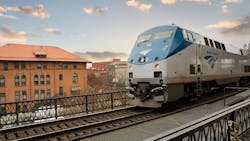New Amtrak OIG report shows Amtrak facing challenges in managing inventory of parts and materials
A new report from Amtrak’s Office of Inspector General (OIG) shows Amtrak is facing challenges in managing its $239 million inventory of parts and materials used to maintain its fleet of locomotives and passenger cars, which can limit the rolling stock available for service, delay trains, limit onboard service and amenities and incur excess costs to manage surplus and obsolete inventory.
While the Amtrak OIG credited the company for implementing a more automated planning process and hiring staff to better manage its maintenance-of-equipment (MoE) inventory (train car and locomotive parts, tools, chemicals and lubricants), OIG auditors identified several challenges that hinder Amtrak’s ability to maintain enough inventory to support operations while avoiding excess costs from having too much.
The report found Amtrak has an imbalance of MoE inventory, which includes more than $49 million in surplus or obsolete items. Amtrak reported it had about $2 million in obsolete inventory for its Heritage fleet, which it acquired from other railroads in 1971 and is no longer in service. Additionally, Amtrak OIG auditors identified $14.4 million in inventory items that Amtrak will likely never use again—funds that Amtrak could have put to better use.
Despite the surpluses in certain items, mechanical employees told the Amtrak OIG that parts are frequently out of stock, leading to operational impacts (limited rolling stock available for service) and increased workload (employees are often required to cannibalize parts while they wait to receive more stock). Inventory shortages also affect the customer experience, the report noted. Amtrak OIG says mechanical employees at two different facilities told the Amtrak OIG that when they did not have parts necessary to repair sleeper cars, passengers were downgraded to coach seating.
Amtrak OIG notes the lack of available parts also leads to hoarding, a practice where mechanical employees order larger quantities of items than they need to store for later use. This distorts the historical data Amtrak uses to predict future inventory needs. In addition, mechanical employees do not always return extra or unused inventory when they order the wrong part or receive too much of an item and they do not always track when they cannibalize parts from another unit. The Amtrak OIG says the practices further distort historical inventory data, leading to a self-perpetuating cycle in which inventory forecasts are inaccurate, there are shortages in inventory and mechanical employees continue to cannibalize and hoard parts.
The Amtrak OIG also found that Amtrak could improve its system for ordering MoE inventory and how it safeguards its inventory. Amtrak OIG says that 95 percent of the mechanical employees interviewed said names and descriptions of items in the ordering system were vague, unclear or the accompanying photographs of the items were wrong or missing. Auditors also identified security vulnerabilities at many of the sites it visited to include absent or incomplete fencing or gates, storage areas accessible to unauthorized employees and non-functional surveillance cameras.
To more strategically manage its MoE inventory, the Amtrak OIG recommended Amtrak implement processes to improve inventory data, develop strategic inventory goals, assess the costs and benefits of carrying surplus and obsolete inventory to determine which materials to sell or scrap and implement processes to safeguard inventory. Amtrak agreed with the report’s recommendations and described ways that it will address them.
The full report can be viewed at Amtrak OIG’s website.
